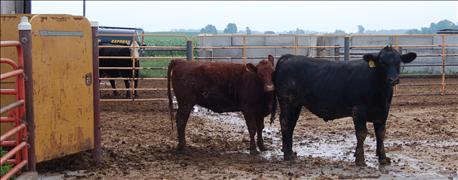
The first case of tuberculosis in cattle in Indiana in several years was reported earlier this summer. Several beef cattle from a farm in Franklin County showed signs of TB in their lungs when examined after slaughter at a slaughter plant. That incident raised eyebrows. When the same strain of TB was confirmed in a 2-year-old white-tailed deer in that general vicinity, it sent off alarm bells.
“That was a game-changer,” says Denise Derrer, director of communications for the Indiana State Board of Animal Health. “This was the first time, to our knowledge, that bovine TB had been confirmed in a wild animal in the state.”

STAY ALERT: All livestock producers need to be aware of the tuberculosis testing program going on in part of Indiana right now.
What are the potential impacts of these developments? Derrer answers Indiana Prairie Farmer's questions.
IPF: How did this incident begin?
Derrer: A slaughter plant discovered TB in several animals from a Franklin County beef herd back in April. At that time, it triggered testing of all cattle within a 3-mile radius. Since the herd is located at both sites, a 3-mile-radius testing area was set up around each site.
IPF: What happened on the farm where the TB was traced to? Was the producer cooperative?
Derrer: The herd was depopulated. Yes, the producer was very cooperative. He keeps excellent records going back several years on all transactions related to his cattle. Those records have been very helpful in determining if any other herds were affected that might have been tied to his herd in one way or another. All testing of these other herds has been negative so far.
IPF: Was this the first time TB had been reported in the area?
Derrer: No. There are four cases in Franklin and Dearborn counties going back to 2008.
IPF: What changed when TB was found in a 2-year-old white-tailed deer in the vicinity?
Derrer: That was a game-changer because by USDA guidelines, it expanded the testing area to a 10-mile radius around the original site. In addition, we have established a testing zone for 2 miles on either side of the Whitewater River running all the way south to the Ohio line. That zone was added because specialists with the Indiana Department of Natural Resources say deer often move up and down that corridor.
IPF: What is the scope of testing that must be done now?
Derrer: Based on our premises identification program, where all locations that have beef or dairy cattle are listed in our system, we have contacted almost 500 owners of cattle herds. The reality is that some of these people no longer have cattle. However, some people who have cattle are not yet in the premises identification system.
IPF: What can people do to help?
Derrer: If you are in the area and had a premises ID but no longer have cattle, please let us know. It will save time and help us update our list. Likewise, if you don’t have a premises ID but now have cattle, please let us know as well. There is no penalty for signing up and getting a premises ID now, even if you didn’t do it before. The last thing we want to do is start knocking on doors.
You can call us at 317-544-2400, or visit our website at boah.in.gov. There is a special page on bovine TB on the website with lots of helpful information.
IPF: Does Indiana still have TB-free status at this point?
Derrer: Yes. However, we need to complete testing in the new 10-mile radius within six months to retain it. Our goal is to complete testing by the end of the year.
About the Author(s)
You May Also Like




